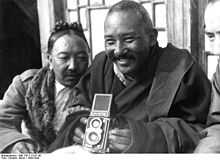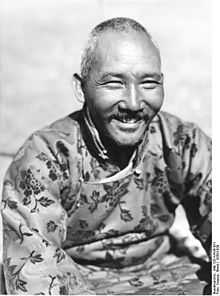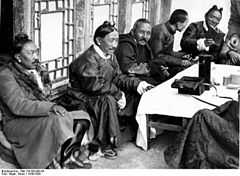Four Rugby Boys

The 1910s saw the attempt to turn four young Tibetans – the Four Rugby Boys – into a vanguard of "modernisers" through the medium of an English public school education.[1]
Lungshar, a Tibetan high official, took four sons of Tibetan "respectable families" – W. N. Kyipup, K. K. Möndö, Gongkar and R. D. Ringang – to England, in 1913, so they could be educated at a public school. After completing their studies at Rugby, each of the Rugby Four received professional training in a particular field and eventually returned to Tibet.
According to Lungshar’s son Lhalu Tsewang Dorje, "the experiment was not a great success.".[2] Historian Alastair Lamb concurs: “the experiment […] can hardly be described as a success”, adding that the boys were sidetracked by the Tibetan establishment and “made no significant contribution in later life to the development of Tibet”.[3]
The experiment
In August 1912, the Dalai Lama asked that some "energetic and clever sons of respectable families" should be given "world-class educations" in England. In early 1913 the youths selected turned up at the British Trade Agency at Gyantse, chaperoned by a Tibetan official called Lungshar. These were W. N. Kyipup, aged 16, K. K. Möndö, a monk, aged 17, Gongkar, aged 16, and R. D. Ringang, 11 years old. The Indian government decided that Basil Gould, who was about to go on leave back to England, should guide the four young boys (known as the "Rugby Boys") on their journey to the United Kingdom and assist them during their first few weeks in England in April 1913.[4]
The Tibetan Boys settled down at Farnham, where they began to learn English under the supervision of the Berlitz School of Languages. It was decided that Rugby would be the best place for their schooling.[5]
W. N. Kyipup

Kyipup studied telegraphy, surveying and cartography. On returning to Tibet, he was assigned the task of developing a telegraph network but failed and was given other assignments.[6]
K. K. Möndö

Möndö studied mining engineering in Grimethorpe and mineralogy in Camborne. Back in Tibet, he went into mineral ore prospecting but was accused of disturbing spirits and spoiling crops and so had to give up prospecting.[7]
Gongkar

Ghongkar went to the military academy at Woolwich and then on to a short period of officer training with the Indian Army[8] as he was expected to later reorganise the Tibetan army. However, for political reasons, he was assigned to a frontier post in Kham.[9] He died from pneumonia in 1917.[10]
R. D. Ringang
The youngest of the lot, Ringang, stayed in England for a longer period and studied electrical engineering at the Universities of London and Birmingham.[11] After returning home, he assembled an electric power station from equipment brought over from England, and laid an electric line to the Dalai Lama’s summer palace in Lhasa, a colossal undertaking. Of the Rugby Four, he was the only one to have achieved something. However, after his death, the plant stopped being maintained for lack of money and fell into disrepair.[12]
The outcome

As Lhalu Tsewang Dorje, Lungshar's son, remarked to British radio operator Robert W. Ford, "The experiment was not a great success" but, according to Ford, the fault did not lie entirely with the boys.[13] Alastair Lamb claims that they were effectively sidetracked by the Tibetan establishment.[14] The experiment was not to be repeated during the remaining period of British rule in the Indian subcontinent.[15]
Tibetologist Alex McKay observes that the three surviving Rugby boys formed, together with their fellow countrymen that had been educated in British India or at Frank Ludlow's English school at Gyantse (1923–1926), "a growing circle of generally progressive thinkers, in whose company Europeans visitors felt comfortable" and who were recognised by the British cadre as "a major propaganda channel."[16]
In 1946, when Austrian war prisoner Heinrich Harrer reached Lhasa, there was only one of the Rugby boys still alive, namely Kyipup, then a high official at the foreign ministry, whose meeting he recalls in his 1954 book Seven Years in Tibet. In the introduction to the book, writer Peter Fleming calls him "the only survivor of a sensible experiment that the Tibetans never got around to repeating."[17]
References
- ↑ British Intelligence on China in Tibet, 1903-1950, Formerly classified and confidential British intelligence and policy files, Editor: A.J. Farrington, Former Deputy Director, OIOC, British Library, London, IDC Publishers, 2002, p. 2: "A fascinating group of files offers minute detail in an attempt to turn four young Tibetans into a vangard of "modernisers" through the medium of an English public school education."
- ↑ (English) Robert W. Ford, Wind Between the Worlds, David McKay Company, Inc, New York, 1957, p. 109.
- ↑ (English) Alastair Lamb, Tom Browns from Central Asia, in The History of Tibet: The modern period : 1895-1959, the encounter with modernity, Alex Mackay, Routledge (ed.), 2003, p. 327.
- ↑ Alastair Lamb, op. cit., p. 325.
- ↑ Alastair Lamb, op. cit., pp. 326-327.
- ↑ Robert W. Ford, Wind Between the Worlds, New York: David McKay Company, Inc, 1957, pp. 107-110, p. 108. The book contains the story of the 4 Rugby boys as related by Lhalu Tsewang Dorje, Lungshar’s son, to British radio operator Robert Ford.
- ↑ Robert W. Ford, op. cit., p. 108.
- ↑ Alastair Lamb, op. cit., p. 327.
- ↑ Robert W. Ford, op. cit., p. 109.
- ↑ Alastair Lamb, op. cit., p. 327.
- ↑ Alastair Lamb, op. cit., p. 327.
- ↑ Robert W. Ford, op. cit., p. 109.
- ↑ Robert W. Ford, op. cit., p. 108.
- ↑ Alastair Lamb, op. cit., p. 327.
- ↑ Alastair Lamb, op. cit., p. 327.
- ↑ Alex McKay, Tibet and the British Raj: the frontier cadre, 1904-1947, Curzon Press, Richmond, 1997, 293 p., p. 136: "They formed a growing circle of generally progressive thinkers, in whose company European visitors felt comfortable. [...] the cadre [...] recognised that 'the pupils from these schools ... constitute a major propaganda channel'."
- ↑ Heinrich Harrer, Seven Years in Tibet, translated from the German by Richard Graves; with an introduction by Peter Fleming; foreword by the Dalai Lama, E. P. Dutton, 1954.